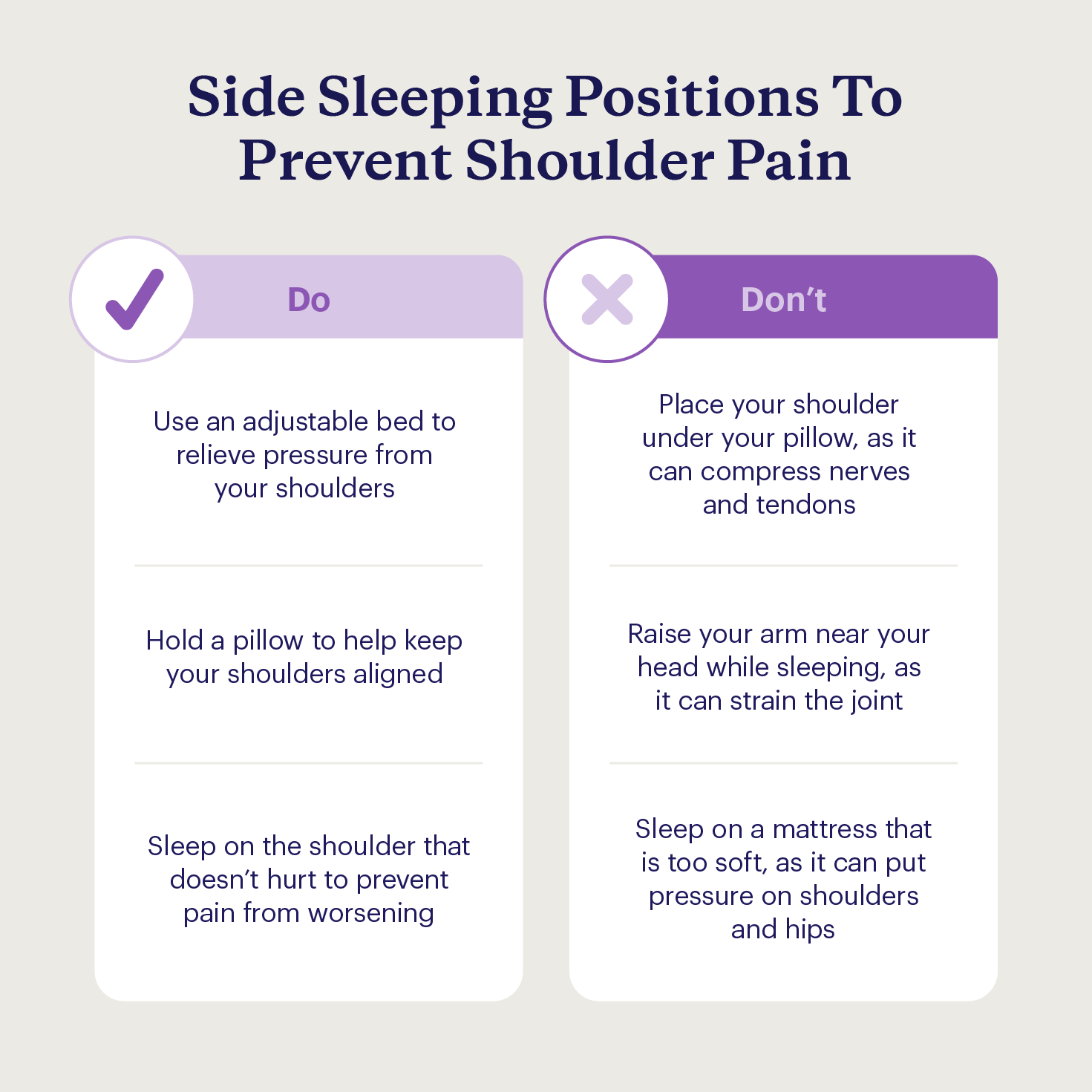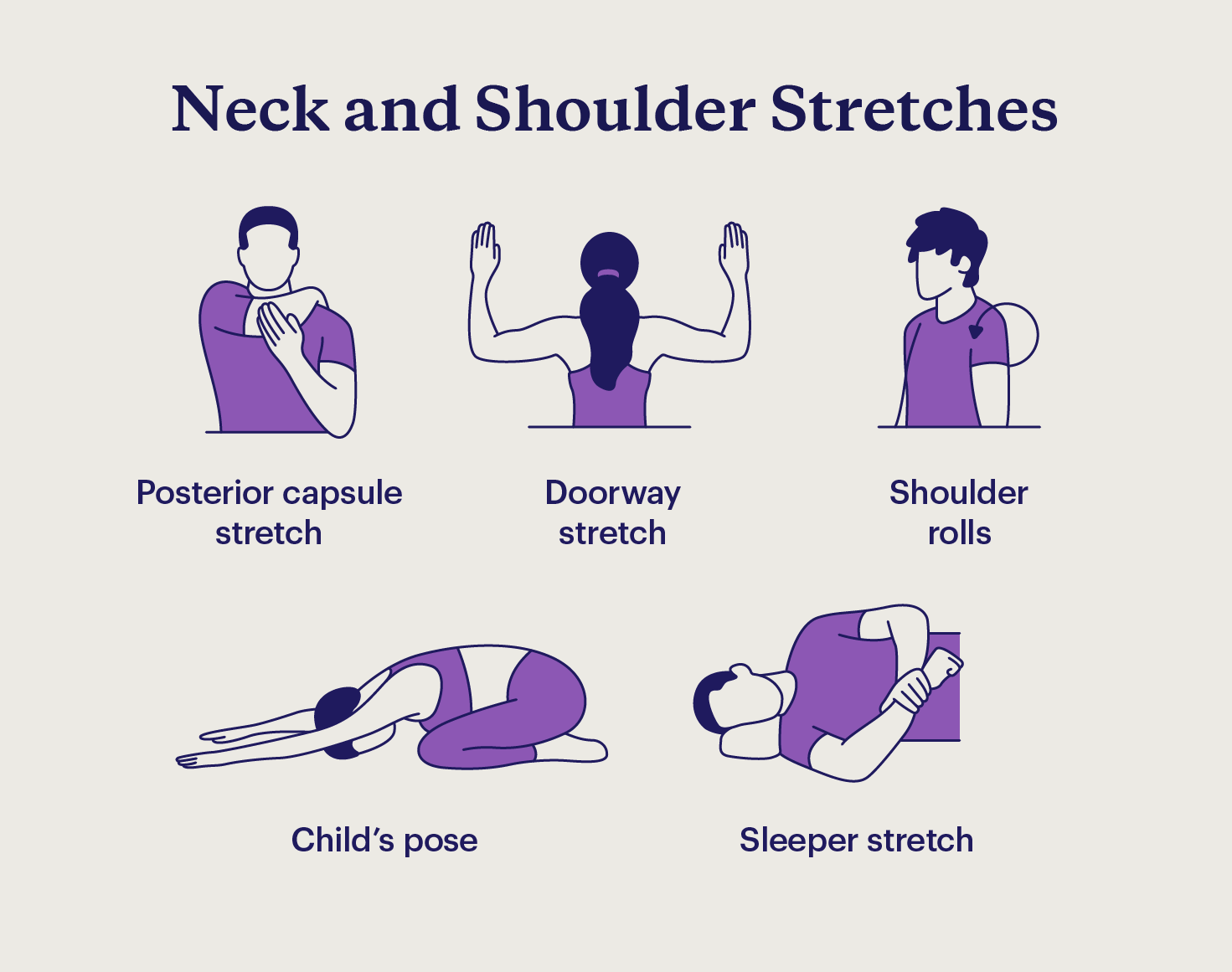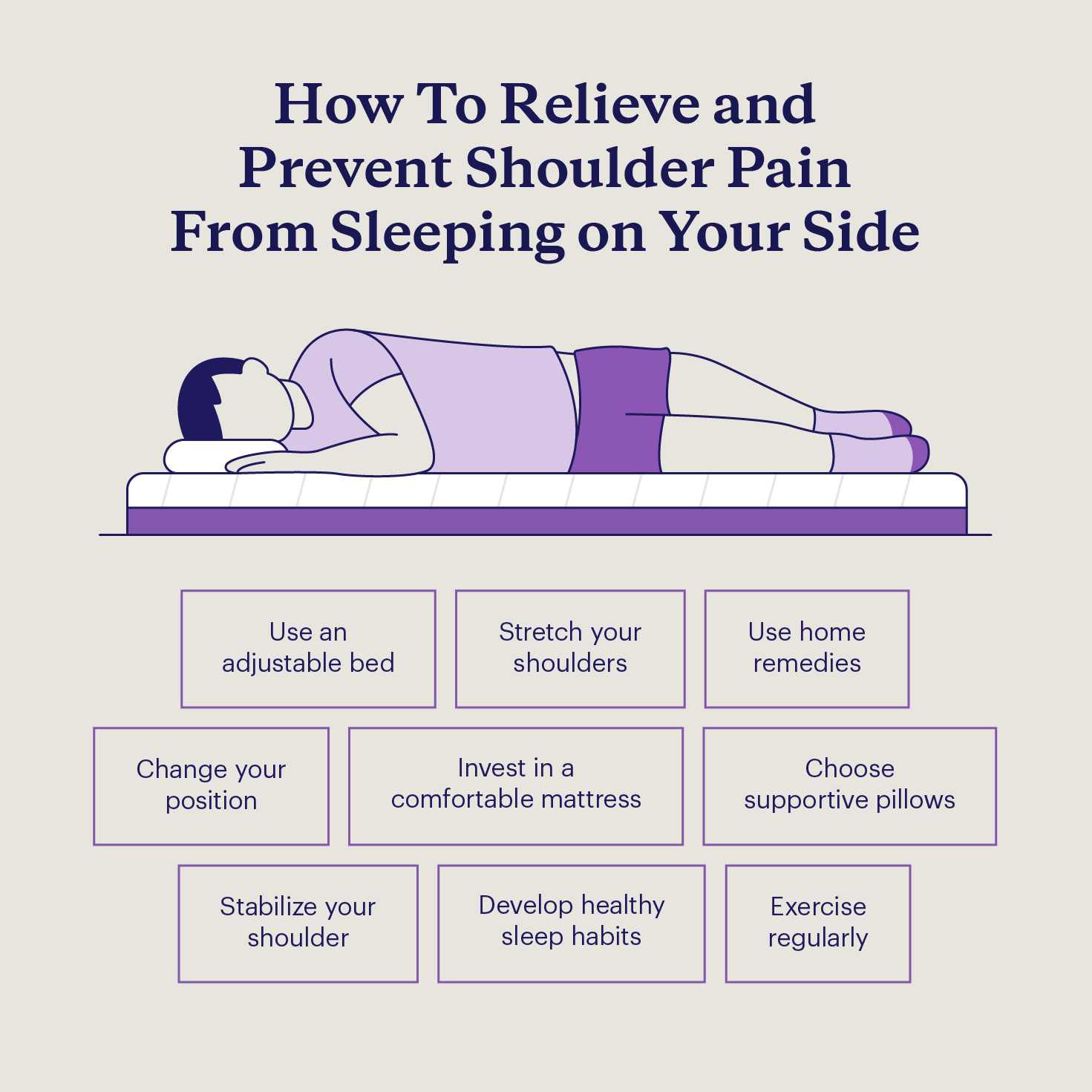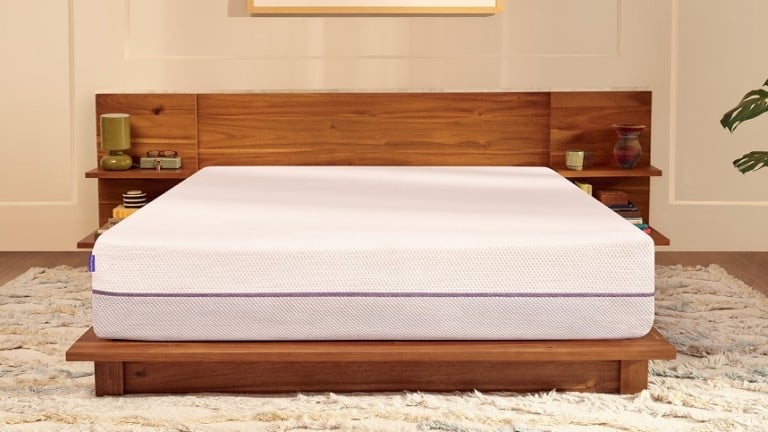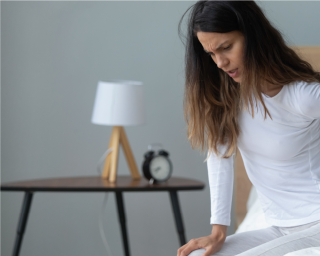
How To Sleep With Shoulder Pain: Causes + Expert Solutions
Key Takeaways
- If you have shoulder pain, try sleeping on your back to take pressure off your shoulders.
- Try stretches and exercises, like doorway stretches and wall angels, before bed.
Comfortable sleep is essential to your performance during the day. Whether you’re sleeping with acid reflux or muscle aches, restless nights are beyond frustrating. Shoulder pain at night can be especially physically and mentally draining.
If you’re a side sleeper, shoulder pain may be a common occurrence for you. Fortunately, there are several strategies that may help reduce shoulder pain from sleeping on your side — from stretches to investing in a more supportive mattress for side sleepers. Keep reading to learn from the experts how to sleep with shoulder pain and wake up more comfortably.
1. Change Your Sleep Position
What’s the best sleeping position for shoulder pain? For most people, sleeping on their back may provide more support, and allow for easier breathing.
Side sleeper shoulder pain is unfortunately common. But if you’re determined to continue sleeping on your side, there are several ways to do so that may reduce discomfort. Here are some other methods of sleeping on your side that may help:
Sleep on Your Other Side
How do you sleep on your side without hurting your shoulder? If one shoulder hurts but the other doesn’t, try switching to sleep on the shoulder that doesn’t hurt.
Even just alternating between sides to avoid one shoulder experiencing too much pressure throughout the night can lessen discomfort. Just make sure you’re using the best pillow for side sleepers, which cushions your head while helping support the natural curves of your spine.
Sleep on Your Back
While sleeping in soldier pose may not come naturally to everyone, there are some ways to learn how to sleep on your back. This includes sleeping with pillows on your side to prevent yourself from rolling over, putting a pillow beneath your knees, or getting an adjustable bed. Make sure you use a low loft pillow — the most recommended pillow for back sleepers — under your head and neck for optimal alignment.
Adjust Your Shoulder Placement
You should also be mindful of how you place your shoulder while sleeping. For example, sleeping with your arm under the pillow can cause shoulder pain, as well as sleeping with your arms above your head. Knowing how to properly sleep on a pillow, whether you are a side sleeper or not, may improve your comfort and sleep quality.
2. Invest in a Comfortable Mattress
Dr. Ryan Peterson, a board certified physician at NuView Treatment Center, says, “Your mattress and pillows should work together to support your body properly. A mattress that's too soft or too firm can throw off your alignment, while the wrong pillow can strain your neck and shoulders all night long.”1
Some people experience both hip and shoulder pain from sleeping on their side, and the culprit may not just be the sleeping position but the mattress itself. If you’re struggling with sore shoulders, finding the best mattress for shoulder pain can help relieve pressure and improve alignment. The level of support the mattress provides, the material it’s made of, and even your type of bedding can all influence your level of comfort and quality of sleep.
Purple’s GelFlex Grid® (also known as a Gel Matrix™) offers support for all types of sleepers. The geometric structure provides both comfort and support, cradling your hips and shoulders no matter your sleep position. In a SleepScore Labs study, sleepers on Purple Restore Collection mattresses reported a 63% reduction in sleep-interfering pain12, helping promote more comfortable, uninterrupted rest.
For example, Purple’s RestorePremier® Hybrid mattress is designed to conform to the body and provide targeted pressure relief for sore joints, making it a supportive option for side sleepers managing hip and shoulder discomfort.
3. Choose Supportive Pillows
Shoulder pain from pillows is also common. If your pillow is too soft or firm, or the loft is too high or low, it may contribute to neck and shoulder pain. Understanding the right firmness and ideal pillow height can help improve sleep quality and lessen discomfort, as it prevents you from sinking too far into the mattress and overcompensating. You may also consider a pillow with an adjustable loft, such as the Purple Freeform™ Pillow.
Pillows can also offer great support if you experience hip pain from your mattress or sleep position. Sleep with a pillow, such as the Purple Harmony Anywhere™ Pillow, tucked between your knees can help keep your body aligned and relieve hip pain while sleeping.
4. Relieve Pressure With a Pillow
You can also use a pillow to support and cushion your affected shoulder.
“The best sleep position is typically on the non-affected side, with a pillow supporting the painful arm across the chest or resting on a body pillow. Sleeping on the back with a small towel or pillow under the elbow to slightly elevate the arm can also relieve tension on the shoulder capsule,” says Dr. Mark Kovacs, founder and CEO of Kovacs Institute.2
5. Try an Adjustable Bed
There are many benefits of an adjustable bed. First, keeping the head elevated may reduce shoulder pain for side sleepers by helping distribute pressure more evenly across the body.
Adjustable beds are sometimes used to help with snoring and sleep apnea, ease symptoms of chronic heartburn, and reduce back or other chronic pain.3
Zero gravity beds are designed to elevate the head and feet to create a weightless feeling, which may enhance comfort.
6. Stretch Your Shoulders and Neck
Regular stretching before bed and when you wake up can help relieve mild neck and shoulder pain from sleeping on your side. Stretching is an important part of any day, whether you have a sedentary office job or a physically demanding labor job. Try one of the best stretches for shoulder pain at night.
As with any exercise, always stop if you experience pain or discomfort. Consult your healthcare provider before starting new stretches if you have an injury, chronic pain, or other concerns or questions.
7. Stabilize Your Shoulder
If your shoulder pain is worse at night, consider stabilizing your shoulder in bed to provide shoulder support. This can include taping your shoulder using special kinesiology tape under the guidance of a physical therapist or healthcare provider, as it helps to support the shoulder and improve comfort while you sleep.
You can also consider a compression sleeve, which applies gentle pressure around the shoulder joint to help with inflammation and pain. Make sure you buy the correct size sleeve so it works properly.
A pressure relief mattress can also help contour and cushion the pressure points like your shoulders.
8. Try Hot and Cold Therapy
Home remedies you can try include icing or applying heat to the affected area. You can use an ice pack or frozen peas wrapped in a towel to ice the area, or a hot pack or warm water bottle (with a cover) to soothe the ache.
Use cold therapy if you’ve experienced an injury or swelling in the last 48 hours. Avoid applying heat during this time. Use heat therapy for ongoing stiffness and/or muscle tension.4 Some people also find alternating heat and cold (contrast therapy) may improve circulation and reduce muscle stiffness, though research is ongoing.5,6
9. Exercise Regularly
Exercise has many benefits. In general, regular exercise can improve overall quality of sleep, by helping regulate energy levels and providing stress relief.7
In particular, dynamic stretching before and after workouts may help reduce the risk of rotator cuff pain and injury, and therefore discomfort associated with sleeping on your side.8 It can also help keep your neck and shoulders from getting stiff or numb overnight.
Always speak with your healthcare provider about starting a new exercise regimen, or seek the advice of a physical therapist for personalized recommendations.
10. Consider OTC Pain Relievers
Over-the-counter pain relievers like NSAIDs (non-steroidal anti-inflammatory drugs), such as aspirin or ibuprofen, may help to manage temporary discomfort before you go to sleep. Make sure to speak to your doctor about whether pain relievers are appropriate for you.
If the pain is persistent and you’ve tried several methods to manage it without relief, consult a healthcare professional and follow their advice about next steps.
11. Develop Good Sleep Habits
If it seems like no matter what you do, you’re still tossing and turning at night and waking up sore and poorly rested, you may need to adjust your sleep habits to get deeper, more restorative sleep. While you may be sleeping through the night, if you’re not spending adequate time in the deeper stages on non-rapid eye movement (NREM) sleep, you may still wake up feeling unrested.
Here are some ways to develop better sleep habits:
- Create a bedtime routine that includes reducing stimulating screen time, getting comfortable, and signaling to your body that it’s time to sleep.
- Limit caffeine, particularly later in the day within 9 hours of your intended bedtime.9
- Limit light and sound in the bedroom with blackout curtains and a white noise machine.
- Cool your room to the ideal temperature for good sleep, which is generally between 60 and 70 degrees Fahrenheit.
4 More Solutions to Shoulder Pain From Sleeping on Your Side
Shoulder pain can be complex and highly individual. Try not to get frustrated if none of the above solutions work for you.
Here are some other approaches you can try:
- Maintain good posture throughout the day.
- Take a hot bath before bed.
- Do cat-cow stretches before bed.
- Try child’s pose before bed.
Keep in mind that, as Mark Kovacs says, “Solutions should be tailored to the underlying condition. For rotator cuff issues, maintaining joint support during sleep and avoiding overhead positioning is key. Frozen shoulder may benefit from gentle pre-bed mobility routines. Bursitis often improves with anti-inflammatory strategies (positioning and ice).”2
Kovacs also notes, “It's always best to combine sleep modifications with a proper diagnosis and physical therapy plan to target the root cause.”2
Best Sleeping Position for Shoulder Pain
So what’s the best position to sleep in to manage shoulder pain at night? Let’s take a look at each sleep position below.
On Your Back
If you’re having issues with your rotator cuff, the best sleeping position for shoulder pain may be on your back.
“In most scenarios, sleeping on your back is going to put the least amount of pressure on the shoulders,” says Thomas Pontinen, MD, LCP-C, physician and co-founder of Midwest Anesthesia and Pain Specialists.
“The only exception to this I can think of in a healthy person is if the mattress is too soft. When the mattress doesn’t offer enough support, the spine can sink into the mattress too much and push the shoulder blades forward. This could, in some cases, contribute to shoulder impingement, muscle imbalance, or excessive pressure on the joint in some scenarios.”10
Back sleepers often enjoy less stiffness and pain, provided they use a supportive mattress that helps maintain spinal alignment.
On the Affected Side
Wondering how to lie on your side without hurting your shoulder? It’s generally not recommended to sleep on the affected side — avoid it if you can.
On Your Other Side
You can try sleeping on your other side to take the pressure off your sore shoulder. However, you then risk aggravating your other shoulder.
Dr. Pontinen says, “I would always advise trying to transition away from side sleeping if possible for anyone who has shoulder pain. If the pain only occurs on one shoulder, and you can’t transition to back sleeping, then try to sleep on the other shoulder, but keep in mind that that shoulder could also start to hurt, especially if it’s supporting all your body weight all night every night.”
He adds, “If the cause of your initial shoulder pain isn’t resolved, then exposing your good shoulder to the same variables is certainly something to avoid.”10
On Your Stomach
Stomach sleeping can often cause stiffness and pain, which is why it’s not generally recommended.
Dr. Peterson advises against sleeping on your stomach with shoulder pain, noting, “This position places your shoulders in a strained, rotated position, which can aggravate shoulder pain.”1
With Shoulder Pain on Both Sides
If both your shoulders hurt, try transitioning away from side sleeping and instead sleep on your back. This may help take some pressure off the shoulders.
With a Shoulder Sling
If you’re recovering from surgery and have a shoulder sling, consult with your doctor on the best way to safely sleep with your sling. Some providers may recommend taking it off at night, and others may advise you to keep it on, depending on your procedure and stage of recovery.
In a Recliner After Surgery
Resting in a recliner may be a practical option after shoulder surgery, especially because you don’t need to put any pressure on your shoulders. Always follow your doctor’s advice about the safest way to rest and recover.
Best Exercises for Shoulder Pain at Night
Vanessa Hill says, “Neck and shoulder stretches may provide temporary relief from shoulder discomfort before you go to bed. Some stretches can aggravate certain shoulder injuries, so consult a healthcare provider if you’re unsure.”
Posterior Capsule Stretch
Also called the crossover arm stretch, the posterior capsule stretch may help provide some shoulder relief. To do it, pull your right arm across your chest and hold your elbow with your left hand, stretching out the shoulder. Repeat on the opposite side.
Doorway Stretch
Using a door frame, rest your arms at a 90-degree angle cactus position. Standing with your feet shoulder-width apart, lean forward to stretch your chest and shoulders. Move slowly and avoid overstretching.
Wall Angels
Place your back against a wall and your feet 6 inches away from the wall. Raise your arms to cactus position with your elbows bent, and then slowly slide your arms up the wall so your hands are above your head. Bring your arms back down to the original position and repeat. Focus on controlled motion rather than range if you feel stiffness.
Shoulder Blade Stretch
Starting with a straight back, squeeze your shoulder blades together and hold it for 10 seconds. Release, and repeat for eight to 12 reps.
Shoulder Rolls
As the name implies, bring your shoulders up toward your ears, rolling them backward and forward to stretch them out.
Neck Release
Tilt your head to the left, using your left hand to pull your head (gently) down to your left shoulder. Feel the stretch in the muscles in the right side of your neck, hold the position for a few seconds, and then stretch the other side.
Child’s Pose
In a kneeling position with your bottom resting on your heels, fold your torso over your knees and bring your hands to the ground in front of you. Aim to rest your forehead on the ground. You should feel this stretch in your spine, hips, and shoulders.
Sleeper Stretch
Start by lying on your side on a hard, flat surface, such as the floor, and reach your bottom arm out in front of your body, with the upper arm flat on the ground and your forearm at a 90-degree angle in front of you. Then, use the opposite hand to gently push your forearm toward the ground. Repeat on the opposite side.
Arm Circles
Stand up and raise your arms out to your sides, moving them either forward or backward, creating little circles. Gradually make the circles bigger and bigger while keeping your arms level with the ground. Then switch directions and repeat.
Causes of Shoulder Pain From Sleeping on Your Side
While side sleeping itself is likely not the sole cause of shoulder pain, it can be a contributing factor, particularly if you have a pre-existing condition that may make you more prone to shoulder discomfort. Here are some common causes of shoulder pain:
- Shoulder impingement: Caused by repetitive motions, swelling, or bone abnormalities, shoulder impingement is when shoulder tendons rub against the nearby bone or tissue, causing pain and inflammation.
- Shoulder bursitis: Bursa are fluid-filled sacs around joints that can become inflamed, causing bursitis. This happens commonly in the shoulders, as well as hips, knees, and elbows.
- Rotator cuff injury: Often associated with repetitive motions and sports injuries, rotator cuff tears and pain are quite common. They involve damage to the muscles and tendons around the shoulder joint. If you’re wondering how to relieve rotator cuff pain at night, check with your healthcare provider before trying new stretches or sleep modifications.
- Osteoarthritis: The most common form of arthritis, osteoarthritis is when the cartilage around joints breaks down over time, causing pain, stiffness, and swelling.
- Tendonitis: Another common injury, tendonitis is the inflammation of the tendons around joints. Bicep tendonitis, rotator cuff tendinitis, and calcific tendonitis are all versions that affect the shoulders.
- Nerve entrapment: Nerve entrapment, or the squeezing of nerves by their surrounding tissues, such as bones, muscles, or tendons, is a painful condition that causes numbness, tingling, and weakness.
- Frozen shoulder: Also called adhesive capsulitis, frozen shoulder is the tightening of the shoulder joint, restricting movement and causing pain. The condition has no clear causes and can last up to three years before resolving on its own.
- Shoulder surgery recovery: You may have pain while recovering from shoulder surgery, and may have to sleep with a shoulder sling.
- General shoulder pain: General shoulder pain could be caused by one or more of the above factors or by sleeping in an awkward position.
If you're struggling with chronic shoulder pain and need a new bed, certain mattresses may be HSA eligible, allowing you to get a more supportive mattress without breaking the bank.
Sleep Better in Any Position With a Purple Mattress
Learning how to sleep with shoulder pain can involve a lot of effort. But you deserve relief — whether it’s from an injury or you just woke up with shoulder pain. While you can try exercises, new sleep positions, and home remedies, upgrading your mattress can also help improve comfort. Make sure to also check for signs you’re sleeping on a bad mattress to determine if your bed is part of the problem.
“I've found that the most common nighttime aggravators are poor posture during the day and sleeping on old, unsupportive mattresses that don't maintain proper spinal alignment,” says Edward Espinosa, owner of OptumMD.11
If you’re tired of waking up with sore shoulders, tight hips, and a stiff neck, upgrade your mattress to Purple. Our GelFlex Grid® technology conforms to your body, balancing comfort and support across different sleeping positions.
FAQ
Yes, continually sleeping on the same side every night without proper support may contribute to shoulder pain. However, there is usually an underlying cause, such as a medical condition or not enough support from your pillows or mattress.
Yes, side sleeping can sometimes aggravate shoulders over prolonged periods. This is particularly true if you don’t have a supportive mattress.
The best position to sleep in with shoulder pain is generally on your back because it reduces pressure on your shoulders.
You likely have shoulder pain when lying down or when you sleep on your side due to the pressure it puts on the joint. Try using a pillow with a higher loft to better support your shoulders and neck.
But if you’re constantly wondering why your shoulder hurts at night, it may be time to visit a doctor.
Avoid neck and shoulder pain from sleeping on your side by sleeping with a pillow between your knees to better align your hips and shoulders or upgrading to a pillow for side sleepers to provide better support.
You can relieve neck and shoulder pain from sleeping on your side by stretching regularly, stabilizing your shoulder with a support sleeve, or using an NSAID like ibuprofen to manage the pain if recommended by your doctor.
Some of the best remedies for shoulder pain include ice or hot packs, shoulder stretches, and over-the-counter pain relievers. If none of that helps, or you’re experiencing unbearable shoulder pain at night, the best thing to do is see a medical professional.
More To Explore
Level up your sleep routine with our most-loved products.


